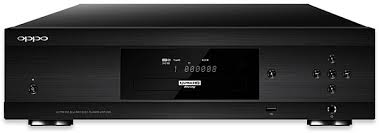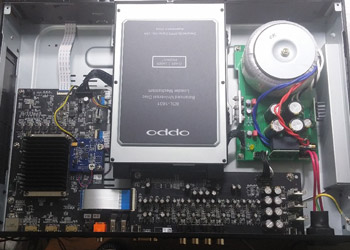I know that
@romaz doesn't post here anymore, though I'm just wondering if Roy or anyone who might have tried Oppo UDP-205 with all kinda upgrades?
http://www.modwright.com/blog/post.php?s=2017-12-18-modified-oppo-udp205-demo-sale
@austinpop actually posted something on CA recently
https://www.computeraudiophile.com/...reaming/?page=236&tab=comments#comment-772093

I've owned numerous Oppo Blu-Ray players dating back to the BDP-83SE and I have always been pleased with their performance for price in my home theater. I thought they hit a home run with their BDP-105 and I considered it the best value entertainment hub I was aware of that included the convenience of a Blu Ray / SACD transport, multi-channel DAC, and a decent headphone amp. With an output impedance of 100 ohms at it's XLR outputs, I was even able to connect my 300-ohm impedance Sennheiser HD800S headphones directly to these XLR outputs and found that it sounded very transparent albeit a bit harsh. I always felt that the Oppo, more than any other device, had the potential of being the ultimate jack-of-all trades A/V device even if it was the master of none. If I was forced into exile to the planet of Xanadu and I could only take with me my HE-1000, a flat panel OLED monitor, my hard drive full of media and one other electronic component, that component would have to be an Oppo.
Oppo upped the ante with the release of the BDP-205 which included true 4K playback capability, Dolby Vision, and ESS's latest ES9038Pro DAC chips, With firmware upgrades, this device has now become a certified Roon Ready network player as well as an MQA-enabled DAC. Typical of most products in this price range, what held this unit back was it's power supply. Oppo saw fit to power the analog section of the BDP-205 with an independent linear-regulated PSU but chose to power the digital section with a switch mode PSU. For some reason, it remains a common belief that analog components benefit from good power supplies while digital components do not.
Back when I owned the BDP-105, while pleased with its feature set, I always felt it could be improved and I contemplated various upgrades from the likes of Modwright, Audiocom, The Upgrade Company, JVB Digital, and Oppmod. Of particular interest to me was the upgrade offerings from Oppomod as they were the only one offering an OCXO clock upgrade option in addition to PSU upgrades. Having exchanged several e-mails with Dr. Lee Jaehong, who personally performs all the mods for this company, I was impressed by what he was willing to offer for a relatively affordable price (at least compared to his competition) but because I could never find any credible reviews, I never took the plunge.
With the release of the BDP-205 last year, I really wanted the 4k playback it offered and so I went ahead and upgraded. I was impressed by how much better this unit was compared to my BDP-105 with regards to both audio and video and so I thought it would be worthwhile to explore my upgrade options once again. I explored the Modwright upgrade and spoke with Dan Wright who informed me that his upgrades focus solely on the analog output stage. In other words, he left the digital side untouched including its noisy switching PSU. Since I generally bypass the analog section of my Oppos in favor of one of my Chord DACs, this particular upgrade had no real appeal for me.

I decided to check out Oppomod again and the first thing I noticed was they were still in business (which I thought was a good sign) and that they had updated their upgrade offerings to include both the OCXO clock and PSU upgrade for the BDP-205. Furthermore, their "Complete mod" upgrade which includes the OCXO, their best LPSU, replacement of the fuse with a circuit breaker, and mods to the DAC board were being offered for only $850 which included return shipping from Korea. While Audiocom was now offering a much more comprehensive upgrade that included a Femto clock, a better PSU, and other tweaks that addressed vibration and RF/EMI, their upgrade was considerably more expensive and so I decided to go with Oppomod. Of course, such mods would void your warranty with Oppo so proceed at your own risk.
What I expected to take a few weeks surprisingly took only a few days and while my Oppo was in Jaehong's possession, he communicated with me frequently, even showing me pictures of the upgrade process. Returned with my newly modified unit was the unit's stock switching PSU. I opened up the unit and it was easy to see the modifications that were performed. As far as quality of workmanship, it appeared top notch. Cables management was very good and nothing rattled when I shook the unit. As soon as I plugged in the unit and turned it on, everything functioned as I remember. This is as seamless an upgrade as there is.

As far as what got better, well, I'm happy to say, quite a lot and more than I was expecting. Video quality improved in terms of better clarity and deeper black levels. Is it the same difference between DVD and Blu-Ray? No, but the improvement is easy to appreciate and was noticed by every member of my family. As far as improvements in audio, this was the surprise because the magnitude of improvement was considerably more than I was expecting. Based on the quality of parts used in the upgrade, I had modest expectations and was expecting this unit to perform on par with something like an Auralic Aries which, to be frank, was an optimistic expectation because I never thought the stock unit when used as a streamer feeding either of my Chord DACs sounded all that great -- passable for movies but not really for audio. With the better PSU, OCXO clock and other mods, there was a very noticeable drop in noise floor, better detail clarity, better detail layering, a greater sense of space, and more dynamic weight and this was evident at low volumes and high volumes with both 2-channel audio and multi-channel video. Is this thing now a world beater? It's not realistic to think that this machine can compete with Esoteric's finest purely as a CD transport and DAC but when you factor in its versatility as a streamer or transport to feed a better DAC, at its asking price of around $2k, this unit would free up funds to allow the purchase of a better DAC and combined with something like a Hugo2, I would now absolutely put it up against Esoteric's finest. How does this unit stack up against my highly regarded Zenith SE when paired with the tX-USBultra and REF10? You would think the Zenith / tX-USBultra / REF10 trifecta would trounce it and you would be incorrect. In blind testing, with this modified Oppo connected to either my Chord DAVE or Hugo2 via Toslink (which is arguably these DACs' best input), a difference can be heard with a slight preference for the trifecta but the difference is barely large enough to matter and certainly not worth more than 5x the asking price of the modified Oppo.
For those content with the qualities of the ESS 9038Pro DAC who are looking for a genuine world class, single-box, Roon Ready, MQA-enabled, multimedia entertainment hub, I'm not aware of a better performing unit for the dollar. Seriously recommended.





